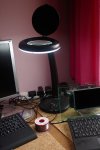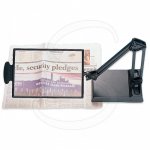The first thing that I did in this respect was to get a good professional relationship with my optician. The problem with standard prescriptions for reading glasses is that the opticians compromise between depth-of-field and close-working distance. I persuaded my optician that a couple of extra dioptres would be most helpful. She was reluctant to prescribe these because the depth-of-field is so limited and I had to make very clear that I understood this aspect and that I would not walk around with these glasses on. The result is a pair of glasses that gives me the best close-up vision that I have had in years; the lenses are multi-coated and I can work with perfect focus from about 200 through 300 mm from my eye. This is like having the vision of my youth again, but only between 200 and 300 mm! Please note; the optician needs to get out the old optical frames with the cabinet of lenses to prescribe these properly; most of the computer-based optical analysers used in the high street chains cannot do this.
Nothing, however, beats a proper stereo microscope; I would not be without mine. It is an obsolete model so there are no details available for purchase, but I selected it very carefully based on my experience with working with a wide range of stereo microscopes professionally. Hippy suggests a camera and screen; this is very limiting because it lacks depth as it is monocular. You really do need stereo to do things properly.
The best stereo microscopes I have ever used are Carl Zeiss and Leica models but these are very much top-cost models. But their most useful features are available in lesser models, therefore it is worth looking at what makes a really good device.
Firstly, the optical head of the microscope needs to prism the image to the eyepieces at 45 degrees; cheap straight-barrelled devices are very tiring to use. My microscope has a working length of 95mm and I find this very reasonable. If the working length is too short then you will find that you are melting the objective lens mount with your soldering iron; too long and you will have to have your work-piece down on your knees. 100mm or so is a reasonable length.
Next, magnification; I find that I set my microscope (which is a rather up-market zoom model) at x5 for most work. This gives me a 40mm diameter field of view. I probably use this for 95% of my electronics and model-making. It zooms up to x15 or switches over (automatic objective lens change) to a zoom range of x15 to x45. At this latter range one is able to examine corrosion on connectors and so forth but such a magnification is pretty useless for any manipulative work. Most of the cheaper stereo microscopes seem to offer high levels of magnification that are useless for manipulative work of the type that we do as electronic hobbyists. I have found that it is not easy to source a microscope with x5-x10 or so because most of the cheap devices are aimed at schools for looking at nature in various forms.
Now, the lighting. The Carl Zeiss microscope that I used had co-axial illumination; that is there was a prism internal to the objective lens that allowed a quartz-halogen illuminator to project the light out from the objective lens. This is absolutely the best system because it is totally shadow-free lighting. I have adapted my own microscope to a "poor-man's" version; I have made a ring of 50 high-output white LEDs that I have mounted circumferentially around the objective lens. As an electronic enthusiast this should be easy for you to do and it is really worthwhile. Any single point light source, no matter how close to the visual axis of the microscope, will give you issues with shadows.
Depth-of-field is a tricky aspect; basically what you are looking for is an objective lens with a small aperture combined with a very high output illuminator, but in practice you just have to take what comes.
Finally, the mounting system. The ideal is to have the microscope head on an arm. The best stereo microscopes such as the ones used by museums for art restoration often have articulated self-balancing spring-loaded arms. These are fantastic but of course they are designed to move over large canvases rather than have the canvas move underneath the microscope. Cheaper stereo microscopes often have an adjustable/lockable boom arm that stands off a mounting post. This is an excellent arrangement because you have complete freedom in the work area. Avoid microscopes that have transmission illumination as well as reflection illumination. The transmission illuminator is mounted in a box beneath the observation stage and has no use at all for manipulative assembly purposes; it just adds height to the microscope and unless you are very tall with a long neck you will find that it just gets in the way of comfort.
So, in summary, look for something that gives you x5 or a zoom with x5 to x15 or so of magnification; has a flat base without under-lighting and has eyepieces at 45degrees to the axis of view. Build yourself an illuminator with a ring of high-brightness LEDs and enjoy the comfort of your new workplace. You will be amazed at how much use you find for such a toy! Have a look at the microscopes in the 'Rapid' website for starters.


